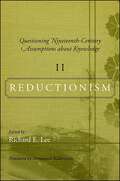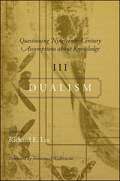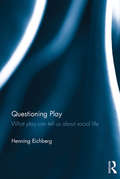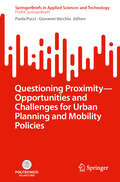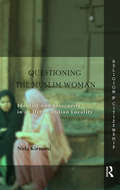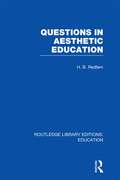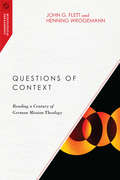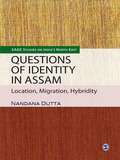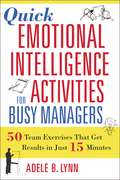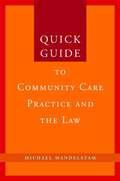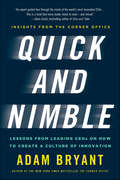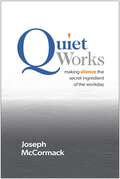- Table View
- List View
Questioning Nineteenth-Century Assumptions about Knowledge, II: Reductionism (SUNY series, Fernand Braudel Center Studies in Historical Social Science)
by Richard E. LeeDuring the last few decades, the fundamental premises of the modern view of knowledge have been increasingly called into question. Questioning Nineteenth-Century Assumptions about Knowledge II: Reductionism provides an in-depth look at the debates surrounding the status of "reductionism" in the sciences, social sciences, and the humanities in detailed and wide-ranging discussions among experts from across the disciplines. Whether or not there is or should be a basic epistemological stance that is different in the sciences and humanities, and whether or not such a stance as exemplified by the approach to reductionism is changing, has enormous consequences for all aspects of knowledge production. Featured are an overview and subsequent discussion of this pervasive concept in the social sciences that parses reductionism into the categories of strong social constructionism and anti-essentialism, social ontology and the apathetic actor, dualisms, and individualism. Also of interest in chapters and follow up discussions are the relations between essentialism and emergentism in complex systems theory.
Questioning Nineteenth-Century Assumptions about Knowledge, III: Dualism (SUNY series, Fernand Braudel Center Studies in Historical Social Science)
by Richard E. LeeDuring the last few decades, the fundamental premises of the modern view of knowledge have been increasingly called into question. Questioning Nineteenth-Century Assumptions about Knowledge III: Dualism provides an in-depth look at the debates surrounding the status of "dualism" in the sciences, social sciences, and the humanities in detailed and wide-ranging discussions among experts from across the disciplines. The extent to which the questionable necessity of a transcendent nomos; individualistic approaches versus systems ontology; rationality—material and formal—and how scholars might overcome the two cultures divide might impinge on the possibility, but not the inevitability, of progress are among the issues explored here. Weaving together in-depth articles and invigorating follow up discussions, this volume showcases debates over the status and validity of dualism. Of special interest are developing alternatives to traditional dualistic categories through an innovative, new approach based on biological naturalism; challenges to the dualism of people and things; the imperfectness and subjectivity of perception; and the overcoming the dualism of philosophy and science.
Questioning Play: What play can tell us about social life
by Henning EichbergWhat is play? Why do we play? What can play teach us about our life as social beings? In this critical investigation into the significance of play, Henning Eichberg argues that through play we can ask questions about the world, others and ourselves. Playing a game and asking a question are two forms of human practice that are fundamentally connected. This book presents a practice-based philosophical approach to understanding play that begins with empirical study, drawing on historical, sociological and anthropological investigations of play in the real world, from contemporary Danish soccer to war games and folk dances. Its ten chapters explore topics such as: play as a practice of search playing, learning and progress the light and dark sides of play playing games, sport and display folk sports, popular games, and social identity play under the conditions of alienation. From these explorations emerge a phenomenological approach to understanding play and its value in interrogating ourselves and our social worlds. This book offers a challenging contribution to the interdisciplinary field of the philosophy of play. It will be fascinating reading for any student or researcher interested in social and cultural anthropology, phenomenology, and critical sociology as well as the ethics and philosophy of sport, leisure studies, and the sociology of sport. .
Questioning Proximity - Opportunities and Challenges for Urban Planning and Mobility Policies (SpringerBriefs in Applied Sciences and Technology)
by Paola Pucci Giovanni VecchioThe book discusses some of the issues related to proximity, challenges an acritical use of the concept and highlights several dimensions that may better frame the actual contribution of proximity to urban and mobility planning in different places. The contributions address the conditions required for ensuring accessibility by proximity and the different planning dimensions that can support its promotion, addressing issues related to the inclusiveness of this model, as well as the scalability and metrics of proximity we need to deal with in several different contexts. The first part of the book introduces some experimental approaches aimed at operationalising accessibility by proximity, while the second part discusses several planning issues related to the implementation of proximity at different scales.
Questioning the ‘Muslim Woman’: Identity and Insecurity in an Urban Indian Locality (Religion and Citizenship)
by Nida KirmaniThe marginalisation of Muslims in India has recently been the subject of heated public debate. In these discussions, however, Muslim women are often either overlooked or treated as a homogenous group with a common set of interests. Focusing on the narratives of women living in a predominantly Muslim colony in South Delhi, this book attempts to demonstrate the complexity of their lives and the multiple levels of insecurity they face. Unlike other studies on Indian Muslims that focus on Islam as a defining factor, this book highlights the ways in which religious identity intersects with other identities including class/status, regional affiliation and gender. The author also sheds light on the impact of such events as the Babri Masjid demolition in 1992 and the subsequent riots, the Gujarat communal carnage in 2002, and the anti-Sikh violence in New Delhi in 1984, along with the rise of Hindutva, and growing Islamophobia experienced worldwide in the post-9/11 period — on the articulation of identities at the local level and increasing religion-based spatial segregation in Indian cities. The study highlights how these incidents combine in different ways to increase the sense of marginalisation experienced by Muslims at the level of the locality. Understanding the need to look beyond preconceived religious categories, this book will serve as essential reading for those interested in sociology, anthropology, gender, religious and urban studies, as well as policymakers and organisations concerned with issues related to religious minorities in India.
Questions in Aesthetic Education (Routledge Library Editions: Education)
by H B RedfernThe Question of what ‘aesthetic education’ is, or might be, is often a source of incomprehension. This book opens up discussion of a complex, difficult, but highly important topic, and offers an introductory survey of the whole area. In examining the relationship of the concept of the aesthetic to that of art, it challenges the persistent linking by many educationists of ‘aesthetic’ with ‘creative’ and the consequent neglect of critical reflection and appreciation.
Questions of Context: Reading a Century of German Mission Theology (Missiological Engagements)
by Henning Wrogemann John G. FlettThe gospel is for every tribe, tongue, and nation (Revelation 7:9), but there is no single biblical or theological model for the relationship between the gospel and these diverse cultures. Indeed, every suggested approach carries its own range of philosophical and theological commitments that all too often remain unexamined. Contextualization is fraught with challenges—yet wrestling with questions of context is essential for how we understand mission, theology, and the embodiment of the Christian faith. German missiology has engaged these questions in a variety of ways that can both inform and critique Anglo-American traditions. In this compilation and analysis, John Flett and Henning Wrogemann translate and comment on a core thread of German missiological works, explaining both their historical and current significance. Drawn from journals and books across a century of academic discourse, these classic writings trace developments from Gustav Warneck, the father of contemporary missiology, through key thinkers such as Karl Hartenstein, who coined the term missio Dei, down to twenty-first century discussions of intercultural hermeneutics. Along the way they reveal advances, mistakes, and changing definitions as German missiologists interacted with the cultural and political realities of their time. This longitudinal study, showcasing many texts available in English for the first time, tackles the history and dynamics of contextualization head-on and sheds new light on the state of missiology today. We are reminded, Flett and Wrogemann argue, that we must keep working to honor difference within the worldwide Christian community as necessary to the fullness of our being in Christ.
Questions of Identity in Assam
by Nandana DuttaQuestions of Identity in Assam: Location, Migration, Hybridity addresses the identity problem in Assam, keenly affected as it is, by the realities of migration and hybridity. The book provides an overview of these issues as they are reflected in the region, and covers the period from the conclusion of the Assam Movement till the present. The Assam Movement spawned a culture of violence which led to the emergence of insurgent outfits in the state. This resulted in the naturalization of violence as a part of everyday living. From this vantage point, the book offers a reading of identity as determined by the anxiety surrounding the presence of the migrants. In this book, the issue of migration is seen through the perspective of the society that receives the migrants and defines itself through a negative response to the other.
Questions that Sell: The Powerful Process for Discovering What Your Customer Really Wants
by Paul CherryIf you ask the right questions, then you&’ll get the sale every time.As a salesperson, your product knowledge is extensive but that's not enough. If you fail to ask the right questions - the ones that uncover a customer's real needs - you will never close the deal.Top sales effectiveness expert and author Paul Cherry reveals advanced questioning techniques that will help you sell your products or services based on value to the customer, rather than price, and increase your success rate as a result.In Questions That Sell, Cherry shares material on how to:Discover hidden customer needs and motivationsReinvigorate a stale relationshipSoothe anxious buyersAccelerate the decision processUpsell and cross-sell so you no longer leave money on the tableUse questions to qualify prospects (without insulting them)And much moreQuestions That Sell is packed with powerful examples, exercises, and hundreds of sample questions for a wide range of buyer interactions. Success is yours for the asking. Smart questioning will get you there.
Quick Emotional Intelligence Activities for Busy Managers: 50 Team Exercises That Get Results in Just 15 Minutes
by Adele LynnThis simple, easy-to-use book gives managers, supervisors, and team leaders activities to help their teams overcome emotional obstacles and become more effective.In a team situation, many issues -- like lack of trust and commitment, unresolved conflicts, and the inability of individuals to understand how their actions impact the rest of the team -- can stop even the most promising groups from delivering great results.In Quick Emotional Intelligence Activities for Busy Managers, you will find powerful, proven exercises they can use to help employees:identify individual and team mooddeal with anger and emotional triggersavert, rather than avoid, conflictencourage communicationovercome fear and other obstaclesunderstand and manage competitionhonor differencesassess team strengths and weaknessespick up on cues from teammatescontrol the emotional climate of the teamEach activity is followed by a discussion of its purpose, how to use it, and a list of post-activity questions to help solidify each lesson. This practical, effective collection of proven exercises will elicit the best from any team.
Quick Fixes: Drugs in America from Prohibition to the 21st Century Binge (Jacobin)
by Benjamin Y. FongDrugs are ubiquitous in the past and present of capitalist society. What can they tell us about our society and economy?Americans are in the midst of a world-historic drug binge. Opiates, amphetamines, benzodiazepines, marijuana, antidepressants, antipsychotics—across the board, consumption has shot up in the 21st century. At the same time, the United States is home to the largest prison system in the world, justified in part by a now zombified &“war&” on drugs. How did we get here?Quick Fixes is a look at American society through the lens of its pharmacological crutches. Though particularly acute in recent decades, the contradiction between America&’s passionate love and intense hatred for drugs has been one of its defining characteristics for over a century.Through nine chapters, each devoted to the modern history of a drug or class of drugs, Fong examines Americans&’ fraught relationship with psychoactive substances. As society changes it produces different forms of stress, isolation, and alienation. These changes, in turn, shape the sorts of drugs society chooses.By laying out the histories, functions, and experiences of our chemical comforts, the hope is to help answer that ever perplexing question: what does it mean to be an American?
Quick Guide Duftmarketing: Wie Sie mit Duftstoffen Ihre Marke stärken (Quick Guide)
by Paul SteinerDieses Buch ist eine kompakte Einführung in das Duftmarketing und bietet Marketing-Verantwortlichen, die ihrem Unternehmen bzw. ihren Marken ein unverwechselbares Duftprofil verleihen möchten, zahlreiche pragmatische Hilfestellungen für die Umsetzung. Es geht darum, mit Hilfe von Duftstoffen den Absatz von Produkten und Dienstleistungen positiv zu beeinflussen bzw. zu steigern, als auch das Markenimage und die Kundenbindung zu stärken. Paul Steiner liefert für die Unternehmenspraxis wichtige Ansatzpunkte zur olfaktorischen Gestaltung von Marken, die durch konkrete Beispiele – Singapore Airlines und MINI – illustriert werden. Interviews mit renommierten Experten aus Wissenschaft und Praxis runden das Buch ab. Der InhaltWahrnehmung und Wirkung olfaktorischer ReizeMarkenrecht – Die DuftmarkeDuftmarketingPraxisbeispiele olfaktorischer MarkenAusblickExperteninterviews
Quick Guide Duftmarketing: Wie Sie mit Duftstoffen Ihre Marke stärken (Quick Guide)
by Paul SteinerDieses Buch ist eine kompakte Einführung in das Duftmarketing und bietet Marketingverantwortlichen, die ihrem Unternehmen bzw. ihren Marken ein unverwechselbares Duftprofil verleihen möchten, zahlreiche pragmatische Hilfestellungen für die Umsetzung. Es geht darum, mit Hilfe von Duftstoffen den Absatz von Produkten und Dienstleistungen positiv zu beeinflussen bzw. zu steigern, als auch das Markenimage und die Kundenbindung zu stärken. Paul Steiner liefert für die Unternehmenspraxis wichtige Ansatzpunkte zur olfaktorischen Gestaltung von Marken, die durch konkrete Beispiele – Singapore Airlines und MINI – illustriert werden. Drei Experteninterviews runden das Buch ab. Die 2. Auflage dieses Werks wurde überarbeitet und um wichtige aktuelle Blickwinkel erweitert. Der Inhalt Wahrnehmung und Wirkung olfaktorischer Reize Markenrecht – Die Duftmarke Duftmarketing Praxisbeispiele olfaktorischer Marken Ausblick Experteninterviews Zielgruppe Dozierende und Studierende aus den Bereichen Marketing, Kommunikation und Werbung Markenverantwortliche, Markenberater Der Autor Paul Steiner ist promovierter Sozial- und Wirtschaftswissenschafter. Neben seiner Promotion mit Auszeichnung zum Dr. rer.soc.oec. an der Wirtschaftsuniversität Wien, erhielt er den Rudolf Sallinger-Preis für seine Diplomarbeit „Sensory Branding&“. Dr. Steiner ist Autor zahlreicher Fachbücher u.a. „Quick Guide Visuelles Marketing&“ (2025), „Quick Guide Haptisches Marketing&“ (2025), „Quick Guide Multisensorisches Marketing<span lang="EN-US" style="font-size: 11.0pt; line-height: 107%; font-family: 'Aptos',sans-serif; mso-ascii-theme-font: minor-latin; mso-fareast-font-family: Aptos; mso-fareast-theme-font: minor-latin; mso-hansi-theme-font: minor-latin; mso-bidi-font-family: 'Times New Roman'; mso-bidi-theme-font: minor-bidi; mso-ansi-language: EN-U
Quick Guide Multisensorisches Marketing: Wie Sie mit allen Sinnen Ihre Marke stärken (Quick Guide)
by Paul SteinerDieses Buch ist eine kompakte Einführung in das Thema Multisensorisches Marketing. Paul Steiner untersucht die marketingspezifische Relevanz des menschlichen Sinnessystems und die verschiedenen Facetten (multisensualen) multisensorischen Brandings und bietet zahlreiche pragmatische Hilfestellungen für die Umsetzung. Für die Unternehmenspraxis werden wichtige Ansatzpunkte zur multisensorischen Gestaltung von Marken geliefert, um so Konsumenten langfristig und mit allen fünf Sinnen an eine Marke zu binden und damit Markeninhalte tiefgreifend zu verankern. Dies wird durch konkrete Beispiele von Singapore Airlines, Swarovski und MINI illustriert. Drei Interviews mit renommierten Experten aus Wissenschaft und Praxis runden das Buch ab. Der Inhalt• Wahrnehmung und Wirkung multisensorischer Reize• Markenrecht – Markenformen mit Sinn• Multisensorisches Marketing • Praxisbeispiele multisensorischer Marken• Ausblick• Experteninterviews
Quick Guide Multisensorisches Marketing: Wie Sie mit allen Sinnen Ihre Marke stärken (Quick Guide)
by Paul SteinerDieses Buch ist eine kompakte Einführung in das Thema Multisensorisches Marketing. Paul Steiner untersucht die marketingspezifische Relevanz des menschlichen Sinnessystems und die verschiedenen Facetten (multisensualen) multisensorischen Brandings und bietet zahlreiche pragmatische Hilfestellungen für die Umsetzung. Für die Unternehmenspraxis werden wichtige Ansatzpunkte zur multisensorischen Gestaltung von Marken geliefert, um so Konsumenten langfristig und mit allen fünf Sinnen an eine Marke zu binden und damit Markeninhalte tiefgreifend zu verankern. Dies wird durch konkrete Beispiele von Singapore Airlines, Swarovski und MINI illustriert. Zwei Interviews mit renommierten Experten aus Wissenschaft und Praxis runden das Buch ab. Die zweite Auflage wurde aktualisiert und durch die Themen Multisensorisches Markendesign, Erlebnismarketing und Multisensorische Markenführung in der Automobilindustrie ergänzt.
Quick Guide Onlinefragebogen: Wie Sie Ihre Zielgruppe professionell im Web befragen (Quick Guide)
by Ulrich Föhl Christine FriedrichDieses Buch zeigt Schritt für Schritt, wie Sie einen professionellen Onlinefragebogen erstellen und ins Feld bringen. Onlinefragebögen gehören als Tool für empirische Untersuchungen mittlerweile zu den Standardmethoden, wenn Rückmeldungen von Kundenzielgruppen oder anderen Stakeholdern eingeholt werden sollen. So können hohe Rückläufe erzielt werden, und die Befragungsergebnisse liegen vergleichsweise schnell für die Auswertung in digitaler Form vor.Der Quick Guide zeigt kompakt auf, wie eine vage umrissene Zielsetzung in konkrete Fragestellungen überführt wird, wie man einen Fragebogen systematisch aufbaut und Fragen richtig formuliert. Zudem wird erläutert, welche Arten von Fragen und Skalen sich für welche Zwecke eignen und wie ein Fragebogen nicht nur verlässliche Erkenntnisse liefert, sondern auch ansprechend auf die Befragten wirkt.Ein Buch für alle Verantwortlichen in Unternehmen, die empirisch zu ermittelnde Fragestellungen haben, sowie Studierende und wissenschaftlich Tätige, die sich als Absender einer Befragung gut präsentieren und für eine hohe Rücklaufquote sorgen wollen.
Quick Guide Sound Marketing: Wie Sie mit akustischen Reizen Ihre Marke stärken (Quick Guide)
by Paul SteinerDieses Buch ist eine kompakte Einführung in das Thema Sound Marketing. Unternehmen stehen heute vor der Herausforderung, ihre Markenwerte durch möglichst viele Sinne gezielt zu vermitteln, um sich von der Konkurrenz explizit abzuheben und Konsumenten langfristig an ihre Marke zu binden.Der Autor liefert Marketing-Verantwortlichen, die ihrem Unternehmen bzw. ihren Marken ein unverwechselbares (akustisches) Profil verleihen möchten, wichtige Ansatzpunkte zur akustischen Gestaltung von Marken, die anhand von Beispielen verdeutlicht werden. Zur Veranschaulichung werden die akustischen Markenzeichen von Audi, Deutsche Telekom, Hyundai, Intel, Lufthansa, Nokia, Siemens und der Wiener Linien analysiert. Der InhaltWahrnehmung und Wirkung akustischer ReizeMarkenrecht - Die KlangmarkeSound MarketingGrenzen und Risiken von Sound MarketingAusblickExperteninterviews
Quick Guide Sound Marketing: Wie Sie mit akustischen Reizen Ihre Marke stärken (Quick Guide)
by Paul SteinerDieses Buch ist eine kompakte Einführung in das Thema Sound Marketing. Unternehmen stehen heute vor der Herausforderung, ihre Markenwerte gezielt über möglichst viele Sinne zu kommunizieren, um sich explizit vom Wettbewerb zu differenzieren und Konsumenten langfristig an ihre Marke zu binden. Marketingverantwortlichen, die ihrem Unternehmen bzw. ihren Marken ein unverwechselbares (akustisches) Profil geben wollen, liefert der Autor wichtige Ansatzpunkte für die akustische Gestaltung von Marken, die anhand von Beispielen veranschaulicht werden. Zur Veranschaulichung werden die akustischen Marken von Audi, Deutsche Telekom, Intel, Lufthansa, Nokia, Siemens und Wiener Linien analysiert. Die zweite Auflage wurde komplett überarbeitet und u.a. um Ausführungen zur akustischen Reizaufnahme und zum Sound Design in der Automobilindustrie ergänzt. Der Inhalt Wahrnehmung und Wirkung akustischer Reize Markenrecht - Die Klangmarke Sound Marketing Grenzen und Risiken von Sound Marketing Der Autor Dr. Paul Steiner ist promovierter Sozial- und Wirtschaftswissenschaftler. Er erhielt seine Promotion mit Auszeichnung an der Wirtschaftsuniversität Wien, wo er auch den Rudolf Sallinger-Preis für seine Diplomarbeit „Sensory Branding“ gewann. Mit herausragenden Leistungen in den Studiengängen Sozial- und Wirtschaftswissenschaften, Betriebswirtschaft, Musikmanagement und Audio Engineering hat er sich einen Namen gemacht. Seit 20 Jahren leitet er komplexe Projekte in der Bauindustrie, Finanzdienstleistungsbranche und Automobilindustrie. Besonders hervorzuheben ist seine Arbeit am BMW Sound Logo, das 2013 den Red Dot Award gewann. Dr. Steiner ist Autor mehrerer Fachbücher, darunter „Quick Guide Sound Marketing“ (2021) und „Sensory Branding“ (2020).
Quick Guide to Community Care Practice and the Law
by Michael MandelstamThis short guide cuts through the confusing mass of legislation to provide a concise and jargon-free explanation of current community care practice and the law. In clear and simple language, it explains the legislation directly relevant to practitioners, including: rules about how people in need get an assessment from local authorities; the assessment of need itself; eligibility for actually getting a service (and the "fair access to care" policy); charging for services; ordinary residence; topping up of care home fees; assessing informal carers; and the rules about asylum seekers. It provides an overview and analysis of high profile issues such as direct payments, personal budgets and the policy of personalisation and National Health Service provision, including the vexed issue of NHS continuing health care. It also highlights the duties placed on local authorities and the NHS, the various tensions underlying community care, and the consequent shortcuts - both lawful and unlawful - that local authorities and the NHS feel obliged to take. Quick Guide to Community Care Practice and the Law is an essential resource for busy practitioners at all levels as well as managers in both the statutory and voluntary sectors, policy-makers in local authorities and the NHS, advocates, lawyers and social work students.
Quick and Nimble: Lessons from Leading CEOs on How to Create a Culture of Innovation
by Adam BryantMore than two hundred CEOs reveal their candid insights on how to build and foster a corporate culture that encourages innovation and drives resultsIn Quick and Nimble, Adam Bryant draws on interviews with more than two hundred CEOs to offer business leaders the wisdom and guidance to move an organization faster, to be quick and nimble, and to rekindle the whatever-it-takes collective spark of a start-up workplace, all with the goal of innovating and thriving in a relentlessly challenging global economy. By analyzing the lessons that these leaders have shared in his regular "Corner Office" feature in The New York Times, Bryant has identified the biggest drivers of corporate culture, bringing them to life with real-world examples that reflect this hard-earned wisdom.These men and women—whose ranks include Jeff Weiner of LinkedIn, Tony Hsieh of Zappos, Angie Hicks of Angie's List, Steve Case of Revolution (and formerly AOL), and Amy Gutmann of the University of Pennsylvania—offer useful insights and strategies for creating a corporate culture of innovation and building a high-performing organization that unleashes the passion and energy of its employees.As the world shifts to more of a knowledge economy, the winners will be companies that can attract and retain the best and brightest employees by creating an environment where they can grow, contribute, and feel rewarded. Through the wisdom of these leading chief executives, Quick and Nimble offers a keen understanding of leadership, recruiting, and the forces that shape corporate culture and a clear road map to bring success and energy to any organization.
Quiet Activism: Climate Action at the Local Scale
by Jason Byrne Wendy Steele Diana MacCallum Jean Hillier Donna HoustonThis book focuses on the potential and possibilities for socially innovative responses to the climate emergency at the local scale. Climate change has intensified the need for communities to find creative and meaningful ways to address the sustainability of their environments. The authors focus on the creative and collaborative ways local- scale climate action reflects the extra-ordinary measures taken by ordinary people. This includes critical engagement with the ways in which novel social practices and partnerships emerge between people, organisations, institutions, governance arrangements and eco-systems. The book successfully highlights the transformative power of socially innovative activities and initiatives in response to the climate crisis; and critically explores how different individuals and groups undertake climate action as ‘quiet activism’ – the embodied acts of collective disruption, subversion, creativity and care at the local scale.
Quiet Is a Superpower: The Secret Strengths of Introverts in the Workplace
by Jill Chang&“Jill is living proof that introverts can thrive in the workplace. . . . A must-have book for today&’s quiet warriors.&” —Susan Cain, New York Times–bestselling author of Quiet and Quiet Power How does a self-described &“extreme introvert&” thrive in a world where extroverts are rewarded and social institutions are set up in their favor? Using her extraordinary personal story, Jill Chang shows that introverts hold tremendous untapped potential for success. Chang describes how she succeeded internationally in fields that are filled with extroverts, including as an agent for Major League Baseball players, a manager of a team across more than twenty countries, and a leading figure in international philanthropy. Instead of changing herself, she learned to embrace her introversion, turning it from a disadvantage to the reason she was able to accomplish great goals. She offers advice on the best jobs for introverts, overcoming the additional difficulties language and cultural barriers can present, thriving at social events and business presentations, leveraging the special leadership traits of introverts, and much more. Part memoir and part career guide, this book gives introverts the tools to understand how they can form relationships, advance in the career path, excel in cross-cultural workplaces, and navigate business settings without compromising comfort or personality. &“Readers will find this book both practical and inspiring.&” —Jennifer B. Kahnweiler, PhD, author of The Introverted Leader, Quiet Influence, and The Genius of Opposites &“Chang provides solid strategies to help . . . introverts shine in their own quiet way.&” —Sophia Dembling, author of The Introvert&’s Way and Introverts in Love &“An invaluable resource.&” —Laurie Helgoe, PhD, author of Introvert Power
Quiet Methodologies: Humility in the Humanities
by Suzanne BostReimagining humanities scholarship with humility and inclusive attention How might foregrounding the writings of colonized peoples transform the ways we work in the humanities? In an era dominated by loud political rhetoric, Suzanne Bost advocates for quieter modes of scholarship: intellectual humility rather than ego, collaboration and conversation rather than singular argumentation, continual reflection and revision rather than defensiveness, and a willingness to believe in different ways of being and knowing rather than adhering to academic norms. With Quiet Methodologies, she demonstrates practical decolonial scholarship and proposes alternative approaches for fostering meaningful engagement. Turning to feminist, queer, and decolonial writings from Gloria Anzaldúa, Alexis Pauline Gumbs, Audre Lorde, and many others, Bost reflects on what we do when we work with literature, culture, and ideas. She weaves together multiple voices, methods of writing, and culturally diverse epistemologies and uses creative devices such as collage, her own original poetry, revision, lists, images, and conversation to disengage academic thought and writing from colonial theories and archives that have passed as neutral. Eschewing conventional monograph formats, her work embraces a reciprocal and heterogeneous learning process with profound ethical implications. Part of a movement of reimagining research and education through care, Quiet Methodologies is a powerful exploration of the possibilities of criticism during crises. It encourages readers to be visionary and pragmatic, challenging current conditions and offering alternative ideas for the future of the humanities. Retail e-book files for this title are screen-reader friendly with images accompanied by short alt text and/or extended descriptions.
Quiet Works: Making Silence the Secret Ingredient of the Workday
by Joseph McCormackWe live—and work—in a world of nonstop noise. It&’s time to reimagine how we work and make silence the secret ingredient. From the time we wake up, our workday starts. We&’re on the smartphone, texting and emailing, scrolling news feeds, jumping on video conference calls. It&’s a 24/7 hamster wheel. Work culture—at the office, hybrid, or remote—is defined by too much information and constant collaboration. There&’s no time and place for thinking alone. In Quiet Works, Joe McCormack proposes a simple, practical, and useful way to work more strategically, and intentionally. You will learn to: Make appointments for quiet, not run from or cancel them Set boundaries to alert others not to disturb or distract you Balance time spent alone in quiet, with time together collaborating Design workspaces that are conducive to quiet Use tools and practices that are realistic and rewarding The noise of constant distractions, interruptions, and digital devices doesn&’t need to defeat us. We can set the conditions for ourselves, colleagues, and organizations to slow down periodically while everything is speeding up. Quiet Works will help you become a stronger professional who is empowered and energized to work in a better, smarter, and more productive way in today&’s competitive, noisy environment.
Quinceañera Style: Social Belonging and Latinx Consumer Identities
by Rachel Valentina GonzálezQuinceañera celebrations, which recognize a girl's transition to young womanhood at age fifteen, are practiced in Latinx communities throughout the Americas. But in the consumer-driven United States, the ritual has evolved from a largely religious ceremony to an elaborate party where social status takes center stage. <p><p>Examining the many facets of this contemporary debut experience, Quinceañera Style reports on ethnographic fieldwork in California, Texas, the Midwest, and Mexico City to reveal a complex, compelling story. Along the way, we meet a self-identified transwoman who uses the quinceañera as an intellectual space in her activist performance art. We explore the economic empowerment of women who own barrio boutiques specializing in the quinceañera's many accessories and made-in-China gowns. And, of course, we meet teens themselves, including a vlogger whose quince-planning tips have made her an online sensation. <p><p>Disrupting assumptions, such as the belief that Latino communities in the United States can't desire upward mobility without abandoning ethnoracial cultural legacies, Quinceañera Style also underscores the performative nature of class and the process of constructing a self in the public, digital sphere.
